The snow false morels (Gyromitra gigas group) are a widely foraged species with some complications. There is some dispute over the naming and range of these species (is it one species or three, or four?) and over edibility. Since it is part of the Gyromitra false morel family, there is also toxicity potential, even if it is low. The snow morel is considered one of the safest, but it can get mixed up with other more toxic false morels, so it is best to be cautious and also 125% sure of your identification.
In this guide, we’ll cover all aspects of identification, naming, foraging, and edibility, including concerns due to its family.
- Scientific Name: Gyromitra gigas group (Discina gigas), Gyromitra korfii, Gyromitra montana, Gyromitra americanigigas.
- Common Names: Snow false morel, snow morel, giant’s false morel, calf brain, and bull nose
- Habitat: Under dead or dying conifers or hardwoods, depending on the species
- Edibility: It’s complicated

Jump to:
All About The Snow False Morels
The snow false morel is a widely foraged species, valued for its bulky dense flesh and early spring arrival. This mushroom is thick and squat – a stocky fungus that appears in scattered groupings. The scientific naming of this species is complicated, but understanding this is a species complex with 3-4 species looking extremely similar from the outside is enough for most people.
As with all the false morels, the edibility issue is complex. Since it is part of the Gyromitra species, it is thought to contain the toxic component gyromitrin and, therefore, be inedible. Or, edible with lots of parboiling. However, in tests, these species have little to no gyromitra present. These tests were done on limited specimens, but most people consider this species to be a “safe” false morel species and okay to eat. We’ll dive deeper into this issue in the section on Edibility.

Another big problem around edibility with this species is that snow morels can be confused with the beefy false morel (Gyromitra esculenta) which contains the most toxins of all the false morel species and MUST be prepared properly if it is to be eaten. Confusing these species, and then doing an improper preparation, can have dangerous consequences. Always make sure you are 100% sure of your identification before consuming this mushroom. And make sure to read up on the beefy false morel and understand the differences between them.
If you’re interested in foraging snow false morels, be aware of the various names so you know what you’re foraging – you don’t want to confuse this species with other false morels! In online and printed resources, you may see any of these names used: Gyromitra gigas, Gyromitra korfii, Gyromitra montana, and Gyromitra americanigigas. These all refer to the snow false morels, and the identification guide for them is the same. To tell them apart, you’ll have to get out the microscope and probably do some dna sequencing. Or, go by where they occur in the country. We’ll dive more into the proper naming further down.
The snow morel was first described scientifically by Julius Vincenz von Krombholz in the 19th century as Helvella gigas. It’s commonly known as the giant’s false morel, calf brain, snow false morel, and, of course, the snow morel.

Snow False Morel Naming Jumble
The names of this species are messy. Previously, it was thought the snow morel was one species, Gyromitra gigas. Then, North American Gyromitra gigas were split, so there were three species, Gyromitra gigas, Gyromitra korfii, and Gyromitra montana. Experts commonly considered them all part of the same species complex, closely related but not exactly the same.
G. korfii and G. montana were naturally split by regional occurrence – G. korfii grows east of the Rocky Mountains and G. montana west of the Rocky Mountains. There is some overlap in the mountains, but not a whole lot. Gyromitra gigas was also thought to occur but was less common and spread out.
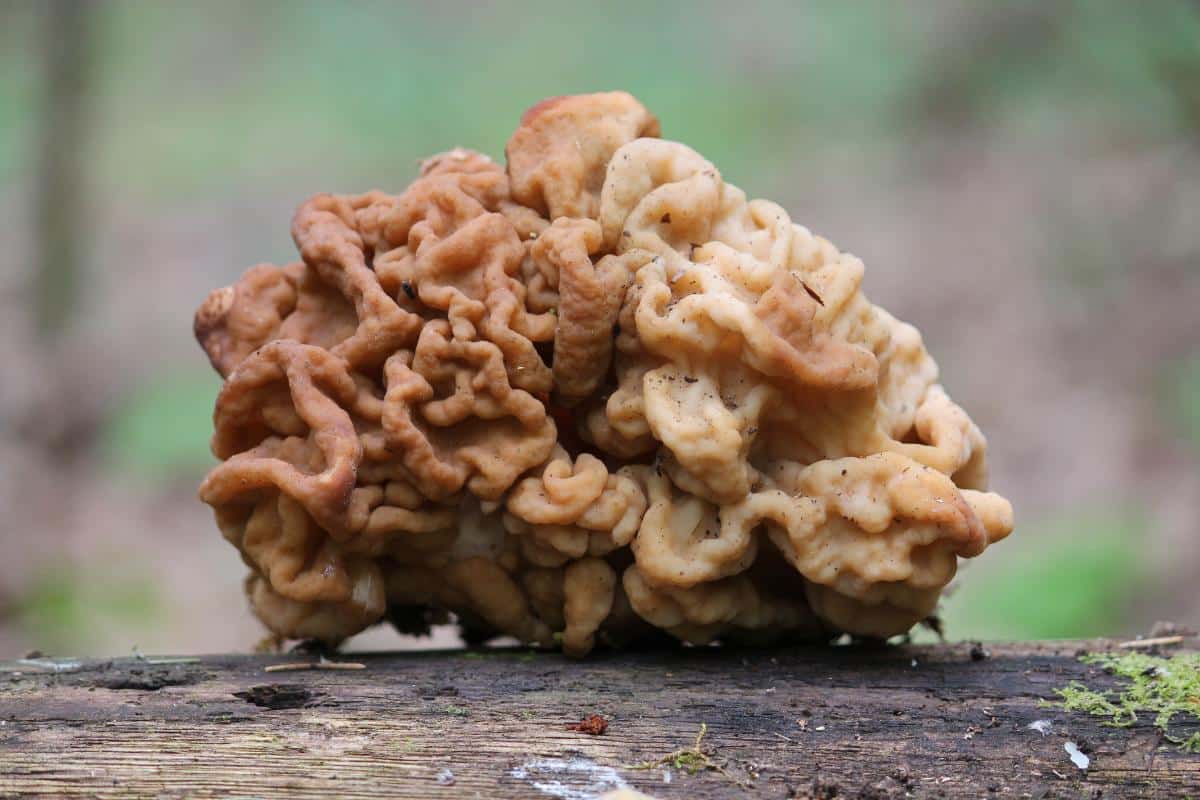
The most current research (Miller, Dirks, Popov 2022) splits Gyromitra gigas even more. In North America, there are still three primary species related to Gyromitra gigas. However, Gyromitra gigas itself is primarily a European species and does not occur in North America (or probably doesn’t). This is extremely confusing for many people because we’ve been calling all these mushrooms Gyromitra gigas for a long time. Now, it likely doesn’t even grow here. The three North American snow false morel species are:
- Gyromitra montana – occurs west of the Rocky Mtns
- Gyromitra korfii – occurs east of the Rocky Mtns
- Gyromitra americanigigas – occurs east of the Rocky Mtns
While the species is split, their outward appearance isn’t much different – the differences are primarily morphological. So, for the forager, the differentiation isn’t a huge issue except to make sure you don’t have a completely different false morel. For the fungi nerds, though, it isn’t very easy to tell them apart except by where they’re growing and their habitat.
All these three species overlap in Michigan! So, if you live there, you’re going to have particular trouble differentiating what you’ve found. Those on the west coast can be assured their snow false morels are G. montana. Foragers on the east coast must determine between G.korfii and G. americnanigagas – knowing the tree species it is growing under will help.

Snow False Morel Identification Guide
Season
Early to late spring, often before the snow fully melts.
Habitat
The preferred habitat is one way to separate the snow morel species.
- Gyromitra montana – grows under dead and dying conifers
- Gyromitra korfii – grows under hardwoods, sometimes from dead trees
- Gyromitra americanigigas – grows under dead or dying conifers
This mushroom is both saprobic (feeding on decaying matter) and potentially mycorrhizal (forming a symbiotic relationship with tree roots). They primarily grow from the ground, but it is not unheard of to see them growing on dead trees, too. They won’t be found on living trees.


Identification
Cap
The cap of the snow morel typically measures between 1.2 and 4 inches high and 1.6 to 3.5 inches wide. The surface of the cap is convoluted and wavy and looks blocky and squarish. Sometimes, it is slightly lobed. It may also be widely wrinkled or have folds, but these are usually loose and undefined. The color ranges from a tan to golden brown to a rich, cinnamon brown.
Snow morel caps hug the top of the stem and are often affixed to them. Even if the cap is not affixed, it is pressed tight to the sides of the stem. The cap flesh is thin – think of a lightweight blanket pulled over the head, just covering your body but not having much substance itself. The cap looks more like a decoration to protect the rest of the mushroom – often, the stem isn’t very visible because the cap’s edges drape down so low.
Spores
The snow morel doesn’t have gills. Instead, it has a smooth hymenium (spore-bearing surface).
Stem
The stem of this mushroom is stout and massive and usually measures between 1.2 and 3.1 inches high and 0.8 to 2.4 inches wide. It is quite often as wide as the cap, or close to it. The stem is pale tan to whitish, has no decorations, and often develops broad vertical ribs or folds. Its substantial size helps support the wide cap.
Flesh
The flesh of the snow morel is whitish and brittle. When cut open, it reveals a chambered structure. It looks like a bunch of tunnels going through the flesh, some filled with stem material or a cotton-like white mycelium.
Odor and Spore Print
This mushroom does not have a distinctive odor. Its spore print is yellow to buff color.





Snow False Morel Lookalikes
Big Beefy False Morel (Gyromitra esculenta)
The beefy false morel is (usually) more erect than the snow morel, with a lobed, wrinkled cap at maturity. It looks much more brain-like with tight, dense wrinkles. However, when both these species are young and still developing, their features can overlap so you have to be extra careful with your identification.
A good way to tell them apart better is by cutting them in half. The snow morels are super dense inside, with thick fleshy stems. The inside of the beefy false morel is usually less tunneled and dense. The beefy false morel must be parboiled before cooking to remove (most of the) toxins.
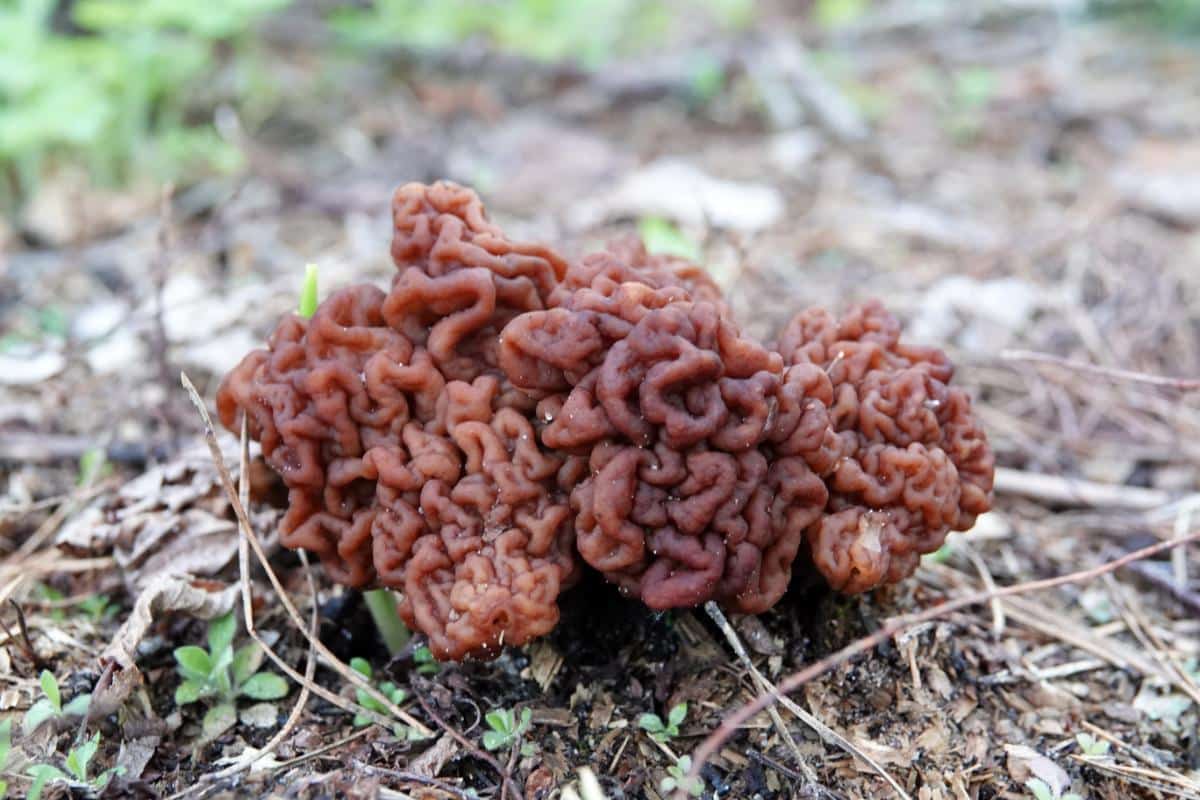
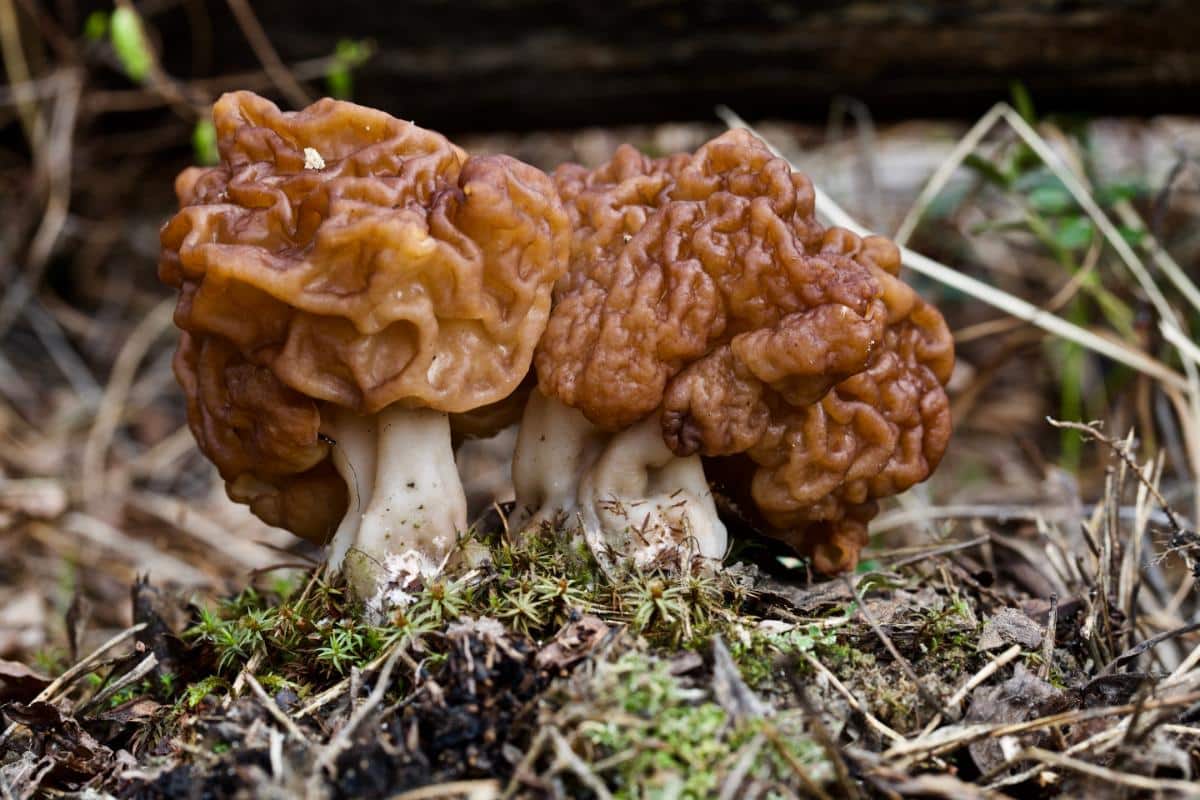
Big Red, Carolina Morel (Gyromitra brunnea)
The carolina big red has a more rounded cap, not blocky like the snow false morel. And, its cap surface has more wrinkles, folds, and convolutions. It also has a stem that is always thinner than that cap, not so stout and wide like teh snow morel.
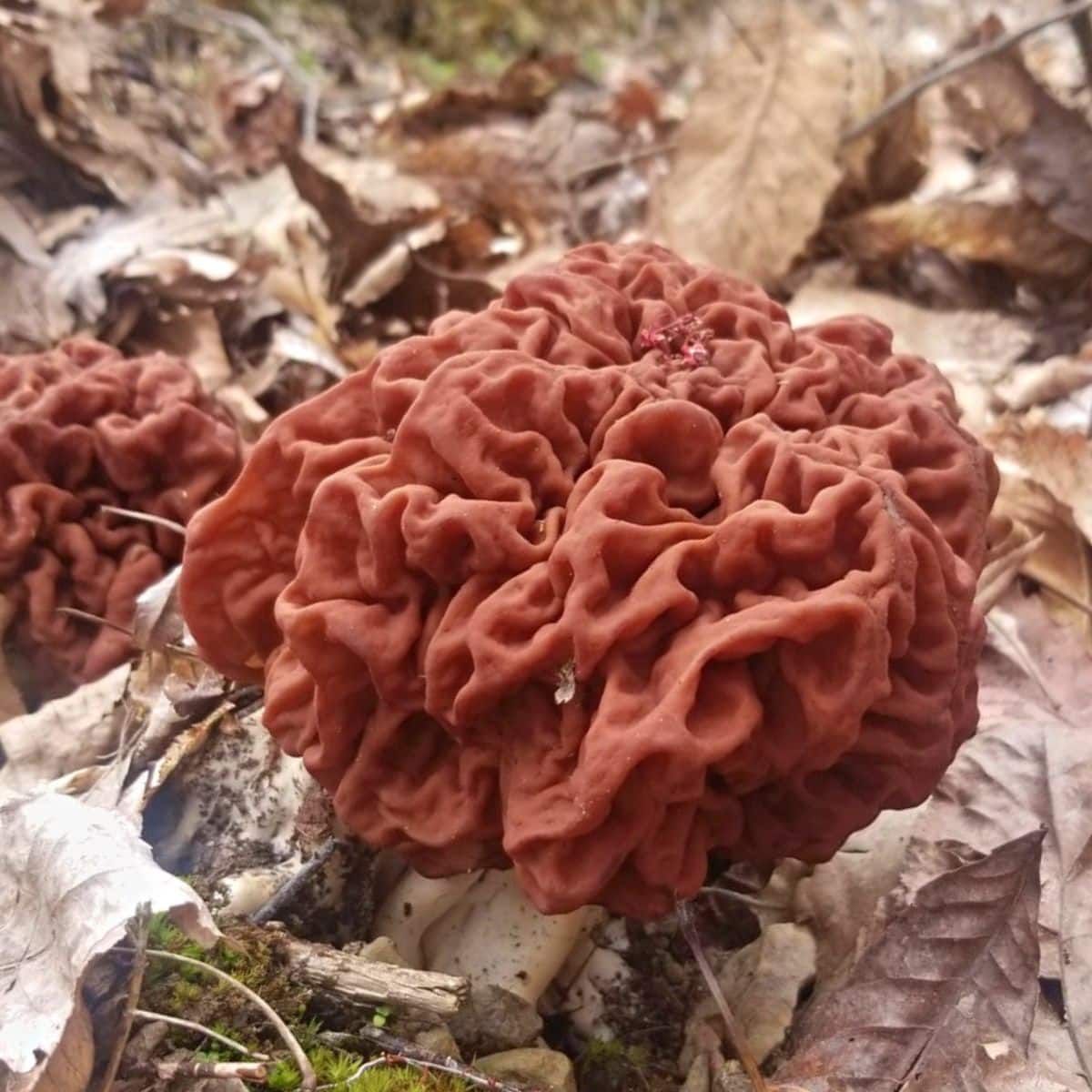
Elfin Saddles (Helvella spp)
Certain species of elfin saddles resemble the Calf’s Brain Mushroom. These mushrooms share a convoluted cap structure but can be distinguished by their more elongated and irregularly shaped caps — the caps look like ears or .. a saddle. They also usually have deep vertical ridges down their stems.

Morels (Morchella spp)
It’s pretty easy to distinguish morels from snow false morels. Their shape and coloring is quite different — the main issue is that they appear at the same time during spring so foragers get hopeful. If you’re ever in doubt, cut the mushroom open. True morels are hollow inside.

Snow Morel Edibility
The edibility of snow morels is a topic of debate, along with all the other Gyromitra species. Some Gyromitra species contain gyromitrin, a dangerous toxin and carcinogen, leading many to label the entire genus as poisonous. However, others argue that not all species contain significant enough quantities of this toxin to make them problematic. Snow false morels, though, have been reported to be safe when cooked thoroughly. However, caution is advised due to insufficient scientific studies assessing its toxicity.
There is also confusion because it seems Gyromitra gigas in Europe does contain gyromitrin and has been the culprit in some poisonings. But, North American species contain little to none – at least not with the specimens tested.
We do not encourage or discourage the foraging and eating of this species. It is up to you to decide whether you want to consume this one.

In general, Gyromitra esculenta, the Beefy False Morel, is known to be the most hazardous due to its high levels of Gyromitrin/hydrazine. This is perplexing, considering that G. esculenta may be the most commonly ingested Gyromitra worldwide. In Finland and Germany, you can find this “poisonous” mushroom for sale in markets and even packaged in cans for sale at the grocery store.
Though it is a cousin of the beefy false morel, the snow morel does not contain nearly as much of this toxin, if any. So, this causes a conundrum. Is this species of Gyromitra totally safe (with cooking!), or should it be avoided just to be safe? And then there’s the issue of the European species in this same G. gigas complex causing poisonings.
While there is no data on the number of people who have consumed Gyromitra without experiencing symptoms, there are statistics on confirmed cases of poisoning. According to the North American Mycological Association’s (NAMA’s) poisoning database, there are no reports of people experiencing toxic effects after eating snow morels in North America.
As a result, Michael Beug, the chair of NAMA’s toxicology committee, suggests that Gyromitra korfii and Gyromitra montana should be considered to have the same toxic status as morels: poisonous when eaten raw but safe when properly cooked. There is no information on Gyromitra americanigigas since it is so newly described. Still, it can be reasonably assumed that foragers and consumers of the gigas complex have also been eating this species without issue.
Notice that in the recommendation, it says when it is properly cooked. This is extremely important. There are methods to remove toxins, if there are any, and they should be followed. Long-term scientific studies have yet to be conducted to assess the presence of toxins in Gyromitra korfii or G. montana, though, so the debate still needs to be solved.
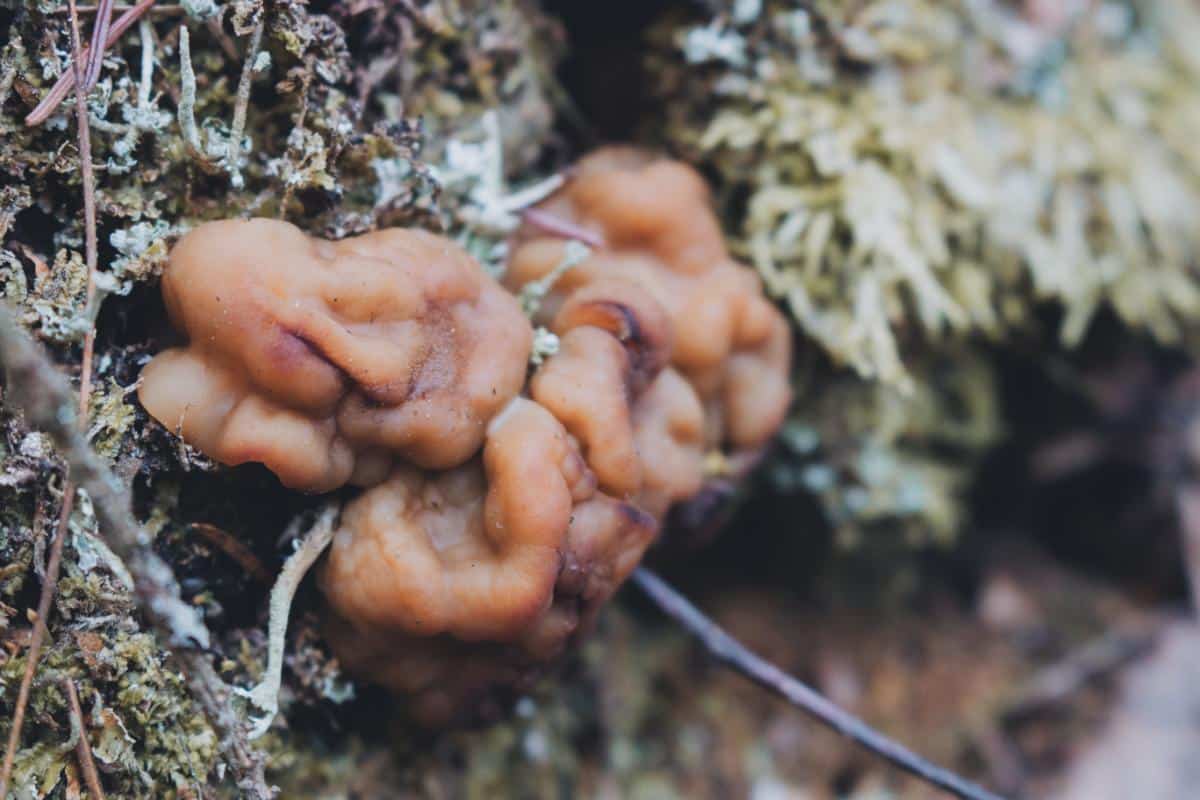
All that exists is knowledge and cultural practices passed down through generations about how to forage and prepare these species. And the lack of known deaths or even reports of poisoning. All in all, if it were truly as poisonous as some state or assume, we’d probably have heard about it. Or we haven’t because most people strongly and steadfastly avoid all Gyromitra species (at least in North America).
If you choose to consume these mushrooms, it is essential to be familiar with the signs of gyromitrin poisoning in order to seek immediate assistance if necessary. Symptoms typically start 2-24 hours after ingestion or inhalation of cooking fumes. These may include intense headaches, gastrointestinal discomfort, vomiting, and severe diarrhea. In some cases, the toxin can be more deceptive and cause harm to the red blood cells, liver, and kidneys, which can ultimately lead to death.
Also, the compound gyromitrin has been identified as a potential carcinogen, possibly leading to the development of cancer in the long run. This is a more concerning aspect compared to its immediate toxic impact.
A lot might depend on where the false morel is foraged from (country, state, county), age, and genetic strain. With Gyromitra species, toxicity levels can vary quite a lot between specimens. Some that are fine in one region are high in toxins in other regions. With snow morels, in particular, there is no data showing where they’re “safer.”

Snow False Morels Cooking and Preparation
If you decide to try snow false morels, preparing and cooking them properly is crucial. Now, there are a lot of people who have been eating these for decades, and they prepare them differently, and that’s fine. In fact, I’m sure this article will get some pushback about my insistence on robust cooking, which includes parboiling. However, I want everyone who has never eaten these to proceed with utmost caution. Maybe it’s being “overly cautious,” and I’m fine with that.
Most people who eat this species don’t do any parboiling as they do with other false morel species. This is due to the reputed lack of gyromitrin. Instead, they cook them like true morels – giving the mushrooms a good long saute before eating.
Remember, you alone are solely responsible for your choice to eat these. And it’s up to you how you prepare them.
Do not serve Gyromitra to individuals unfamiliar with the mushroom and the edibility controversy!

Snow false morels have a meaty and savory mushroom flavor. Their width and denseness make them highly sought after because they make quite a substantial meal. These are pretty dense, meaty mushrooms.
Unfortunately, these are not easy mushrooms to prep. The flesh is brittle, especially in the cap. Also, cleaning these mushrooms can be a pain in the neck. The chambered stem is a common hiding place for insects and spiders. Simply rinsing them off is not enough since the water cannot reach every cavity.
To get all the bugs, slice and wash each piece thoroughly. Trim the mushrooms at the base to get rid of the dirt that tends to stick there.
Parboiling Preparation
Parboiling is recommended before cooking. However, be aware that the mushroom’s brittle flesh may result in smaller pieces than desired.
- Before cooking Gyromitra mushrooms, open all the windows in your kitchen. Turn on the kitchen hood fan if there is one. Alternatively, you can use a box fan to blow air out of the kitchen. (This may be overkill, but it certainly doesn’t hurt.)
- Boil a pot of water and add the cleaned and prepped snow morels. Cover the pot and bring it back to a rolling boil. Cook for 10-15 minutes, depending on the quantity, until the mushrooms look wilted and fully cooked.
- Remove the mushrooms from the water and discard the water.
- Place the mushrooms between paper towels and press to remove excess water.
- Cook up as desired (frying is a standard method)
If you’re interested in further reading and learning more about eating false morels, check out these link:
- Cytotoxic fungi, an overview.
- False Morels Demystified Facebook Group
- Not all bad: Gyromitrin has a limited distribution in the false morels as determined by a new ultra high-performance liquid chromatography method
- Gyromitra Mushroom Poisoning
- False Morel Mushrooms: Everything You Need To Know
- Historic Edibility Assessments for “False Morel”, Gyromitra esculenta
- Poisoning by Gyromitra exculenta – a review
- Case Report: Acute liver injury, acute liver failure and acute on chronic liver failure: A clinical spectrum of poisoning due to Gyromitra esculenta
- Gymomitra esculenta, Tom Volk’s Fungus of the Month
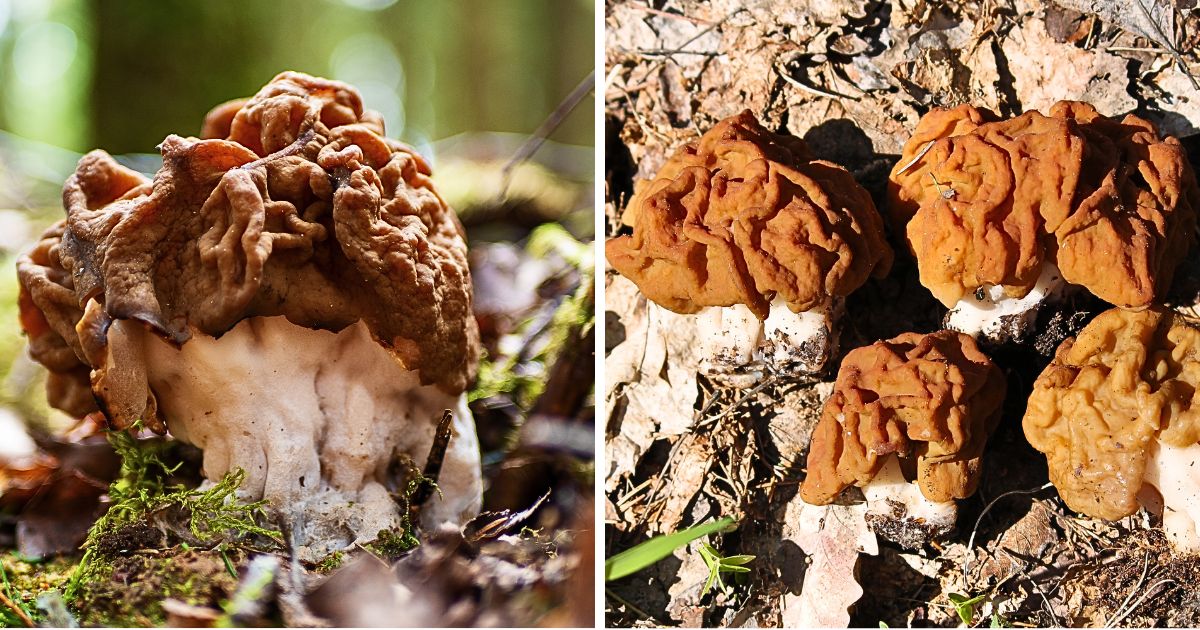
Snow False Morels Common Questions
Do snow morels have medicinal properties?
Currently, there are no known medicinal properties associated with the snow morel.
Is the snow false morel edible?
Yes, with caution. The snow morels, Gyromitra korfii, Gyromitra montana, and Gyromitra americanigigas, are widely consumed in areas where they grow. Most people consider them to be a safe species and prepare them similarly to true morels. However, species in this family are known to contain toxins. Whether you consider this species edible or not depends on your risk factor. There are ways to prepare it that reduce the toxins and make it “safe.”
Does the snow false morel have dangerous lookalikes?
Yes. Snow morels can be confused with the beefy false morel (Gyromitra esculenta) which contains the most toxins of all the false morel species and MUST be prepared properly if it is to be eaten. Confusing these species, and then doing an improper preparation, can have dangerous consequences. Always make sure you are 100% sure of your identification before consuming this mushroom.





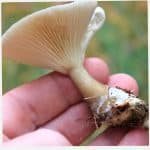



Leave a Reply